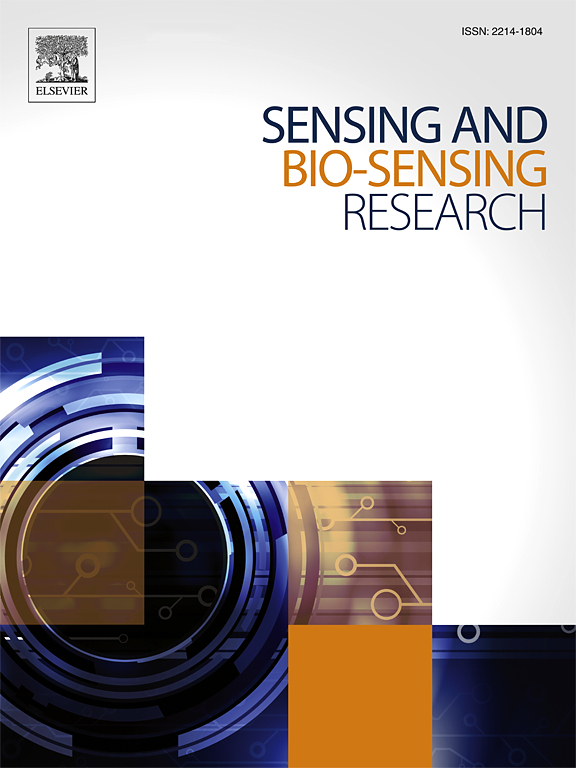用于感应磷酸盐缓冲盐水溶液中电解质浓度的太赫兹带状波导
IF 4.9
Q1 CHEMISTRY, ANALYTICAL
引用次数: 0
摘要
实验证明了一种亚波长厚多孔带波导(PRW)可用于太赫兹(THz)区域的生物电解质传感。在太赫兹时域光谱测量中,利用横磁波导模式在PRW上传播的传输损耗常数作为太赫兹感测信号,发现其与PRW芯中吸附的电解质量呈线性响应关系。由TM波导模式的空间限制引起的传播损耗变化可以通过填充电解质的PRW芯的厚度和折射率的变化来改变。利用太赫兹传感信号的响应曲线和一维模态功率分布在测量和仿真中验证了这些发现。实验证明,基于prw的传感平台的检测灵敏度达到0.092 cm−1/(μg/mm2),电解质场相互作用长度仅为1 cm。在0.15 ~ 1.52 M的检测浓度范围内,检测磷酸盐缓冲盐水溶液中电解质摩尔浓度变化的检出限为23.52 mM,对应的分子密度变化低至18.18 nmol/mm2。其传感性能明显优于其他太赫兹传感技术。简单且具有成本效益的基于prw的传感方法能够在短的相互作用长度内有效检测痕量分析物,这是非常适合各种生化传感应用的关键特征。本文章由计算机程序翻译,如有差异,请以英文原文为准。
Terahertz ribbon waveguide for sensing electrolyte concentration in phosphate-buffered saline solution
A subwavelength-thick porous ribbon waveguide (PRW) has been experimentally demonstrated for sensing biological electrolytes in the terahertz (THz) regime. The transmission loss constant of the transverse-magnetic (TM) waveguide mode propagating on a PRW is used as the THz sensing signal and found to be linearly responded to the quantity of electrolytes adsorbed in the PRW core in the measurement of THz time-domain spectroscopy. The propagation-loss change arising from the spatial confinement of the TM waveguide mode can be altered by variations in thickness and refractive-index of the electrolyte-filling PRW core. These findings were verified using the response curve of the THz sensing signal and the one-dimensional modal power distribution in both measurements and simulations. The detection sensitivity of the PRW-based sensing platform was experimentally demonstrated to achieve 0.092 cm−1/(μg/mm2) with an electrolyte-field interaction length of merely 1 cm. The limit of detection for sensing molar concentration changes of electrolytes in phosphate-buffered saline solutions was 23.52 mM within the detectable concentration range of 0.15–1.52 M, corresponding to a molecular density change as low as 18.18 nmol/mm2. The sensing performance significantly surpasses that of other THz sensing technologies. The simple and cost-effective PRW-based sensing approach enables efficient detection of trace analytes over a short interaction length, which is the critical feature to be well-suited for various biochemical sensing applications.
求助全文
通过发布文献求助,成功后即可免费获取论文全文。
去求助
来源期刊

Sensing and Bio-Sensing Research
Engineering-Electrical and Electronic Engineering
CiteScore
10.70
自引率
3.80%
发文量
68
审稿时长
87 days
期刊介绍:
Sensing and Bio-Sensing Research is an open access journal dedicated to the research, design, development, and application of bio-sensing and sensing technologies. The editors will accept research papers, reviews, field trials, and validation studies that are of significant relevance. These submissions should describe new concepts, enhance understanding of the field, or offer insights into the practical application, manufacturing, and commercialization of bio-sensing and sensing technologies.
The journal covers a wide range of topics, including sensing principles and mechanisms, new materials development for transducers and recognition components, fabrication technology, and various types of sensors such as optical, electrochemical, mass-sensitive, gas, biosensors, and more. It also includes environmental, process control, and biomedical applications, signal processing, chemometrics, optoelectronic, mechanical, thermal, and magnetic sensors, as well as interface electronics. Additionally, it covers sensor systems and applications, µTAS (Micro Total Analysis Systems), development of solid-state devices for transducing physical signals, and analytical devices incorporating biological materials.
 求助内容:
求助内容: 应助结果提醒方式:
应助结果提醒方式:


